The days of scratching your head over which beaches on Whidbey Island are public and which are private may be numbered.
After an exhaustive inventory effort, Island County parks officials are in the process of revising its list of county parks land. While there is still a lot of work left to do, more than 20 little known public properties have been added to the list of Whidbey Island properties alone, and many are public beach accesses.
“We still need to do research on tidal access, but these are properties where people can get to the shoreline,” said Bill Oakes, director of Island County Public Works.
“It’s our intent to make known these public beach accesses,” he said.
Late this past year, the Island County commissioners adopted a comprehensive plan outlining the direction parks will take in the future. Part of the effort included an inventory of all publicly owned property in the county.
The idea, said Oakes, was to study patterns of use and identify all property owned by county taxpayers. The inventory yielded a few surprises, such as a handful of small parcels in residential areas that no one knows how or why were acquired.
They may be auctioned off, while a few other properties, such as two off-leash dog parks on North Whidbey, may be passed off to neighboring municipalities or junior taxing districts.
As for shoreline properties, the inventory effort established with certainty at least a dozen beaches and public beach accesses. They are expected to be added to the existing list of park lands posted online sometime this summer.
Identifying these properties was important for several reasons, Oakes said. First, while creating the parks plan it became clear that the public placed a high value on the preservation of beach accesses.
It was important for logistical reasons, as well. Individual parks have never before been formally identified in the county code. Oakes hopes to rectify that, opening up the possibility for each property to be eligible for grants that might fund projects that would otherwise never move forward.
Langley resident Mike McVay, a beach access champion who has been fighting for public shoreline rights for years, is applauding the county’s effort and calling the new list a great start.
“It’s absolutely good news,” McVay said.
He is the founder of Island Citizens for Public Beach Access, a loose association of people who independently work to identify and preserve taxpayer-owned shorelines on Whidbey and Camano islands.
Because public beaches are usually surrounded or abut private property, disputes about ownership are not uncommon. Identifying who owns what can be laborious and complicated, but it’s not impossible, McVay said.
In fact, while he said the county is doing more than ever before to identify public beaches, they’ve only just scratched the surface. For example, the county’s new list shows three public beach accesses on Sunlight beach but he claims there may be as many as nine.
Joantha Guthrie, project manager for Public Works, agrees that the process is both complicated and time consuming. While county officials are certain that the public has some rights associated with each property on the list, the extent of each is not yet clear, she said.
“That’s a big, big issue,” Guthrie said.
“We can’t just slap up a sign that says public beach,” she said.
According to Oakes, Marissa Lane at Sandy Point near Langley is the only property that has been studied in enough detail for the county to post signs that indicate just how much of the beach is open to the public.
It took a long time and thousands of dollars to determine with certainty that about 20 feet of the beach was available for public use. And other properties are even more complicated, Oakes said.
Perhaps the most famous dispute over shoreline access concerns the property at the end of Wonn Road in Greenbank. It’s not on the new parks list and has been under legal investigation by the county for several years.
Oakes said he could not comment on the property due to potential litigation with landowner Bruce Montgomery.
The process of how the county goes about studying each new listed park property, and in what order, is expected to be cleared up once the planning department finishes its shoreline master program update this year.
Establishing the order in which each is tackled will be an important step due to the expense of studying each site. They will likely be tackled one at a time as funding becomes available.
“This will be a long process,” Oakes said.


